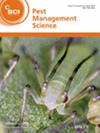Evaporation, spreading, and possible uptake of droplets on sorghum (Sorghum bicolor) and cowpea (Vigna unguiculata) leaves using an imaging‐based technology
Iaroslav Makhnenko, Cody Hoerning, Dustyn D Sawall, Steven A Fredericks, Elizabeth R Alonzi, Cari S Dutcher
求助PDF
{"title":"Evaporation, spreading, and possible uptake of droplets on sorghum (Sorghum bicolor) and cowpea (Vigna unguiculata) leaves using an imaging‐based technology","authors":"Iaroslav Makhnenko, Cody Hoerning, Dustyn D Sawall, Steven A Fredericks, Elizabeth R Alonzi, Cari S Dutcher","doi":"10.1002/ps.8491","DOIUrl":null,"url":null,"abstract":"BACKGROUNDSprayed agrochemical droplets have a dynamic evolution on the leaf surface, undergoing changes in shape and volume due to spreading, evaporation, and adsorption. To better understand these processes, an accessible imaging‐based experimental methodology is presented to precisely measure droplet spreading, evaporation, and potential uptake by a leaf within a controlled relative humidity environment. Laboratory experiments were conducted to determine the effect of hydrocarbon surfactants, accelerators (light mineral oil), and humectants (high fructose corn syrup) on droplet spread, evaporation, and potential uptake when applied to sorghum (<jats:italic>Sorghum bicolor ‘Tricker’</jats:italic>) and cowpea <jats:italic>(Vigna unguiculata</jats:italic>) leaves.RESULTSExperiments on cowpea leaves showed uniform spreading and no change in evaporation compared to the predicted rate. In contrast, on sorghum leaves, results suggest that the volume loss rate exceeds the predicted evaporation rate (up to 23%), indicating a potential uptake by the leaves. Some accelerated dynamics on sorghum can be attributed to the lateral spreading observed on hairy leaves along the veins, increasing the contact area by an average of 65%. However, samples containing light mineral oil, typically considered an accelerant to aid in uptake, demonstrated the highest rate but exhibited minimal spreading.CONCLUSIONSThe study demonstrates how droplet composition affects droplet dynamics on waxy and hairy leaves by using an imaging‐based methodology to measure evaporation rates, volume loss, contact angle, wetted area, and spreading behavior. The findings highlight some of the complex coupling between the crop protection product composition and droplet life cycle on a leaf. © 2024 The Author(s). <jats:italic>Pest Management Science</jats:italic> published by John Wiley & Sons Ltd on behalf of Society of Chemical Industry.","PeriodicalId":218,"journal":{"name":"Pest Management Science","volume":"34 1","pages":""},"PeriodicalIF":3.8000,"publicationDate":"2024-10-30","publicationTypes":"Journal Article","fieldsOfStudy":null,"isOpenAccess":false,"openAccessPdf":"","citationCount":"0","resultStr":null,"platform":"Semanticscholar","paperid":null,"PeriodicalName":"Pest Management Science","FirstCategoryId":"97","ListUrlMain":"https://doi.org/10.1002/ps.8491","RegionNum":1,"RegionCategory":"农林科学","ArticlePicture":[],"TitleCN":null,"AbstractTextCN":null,"PMCID":null,"EPubDate":"","PubModel":"","JCR":"Q1","JCRName":"AGRONOMY","Score":null,"Total":0}
引用次数: 0
引用
批量引用
Abstract
BACKGROUNDSprayed agrochemical droplets have a dynamic evolution on the leaf surface, undergoing changes in shape and volume due to spreading, evaporation, and adsorption. To better understand these processes, an accessible imaging‐based experimental methodology is presented to precisely measure droplet spreading, evaporation, and potential uptake by a leaf within a controlled relative humidity environment. Laboratory experiments were conducted to determine the effect of hydrocarbon surfactants, accelerators (light mineral oil), and humectants (high fructose corn syrup) on droplet spread, evaporation, and potential uptake when applied to sorghum (Sorghum bicolor ‘Tricker’ ) and cowpea (Vigna unguiculata ) leaves.RESULTSExperiments on cowpea leaves showed uniform spreading and no change in evaporation compared to the predicted rate. In contrast, on sorghum leaves, results suggest that the volume loss rate exceeds the predicted evaporation rate (up to 23%), indicating a potential uptake by the leaves. Some accelerated dynamics on sorghum can be attributed to the lateral spreading observed on hairy leaves along the veins, increasing the contact area by an average of 65%. However, samples containing light mineral oil, typically considered an accelerant to aid in uptake, demonstrated the highest rate but exhibited minimal spreading.CONCLUSIONSThe study demonstrates how droplet composition affects droplet dynamics on waxy and hairy leaves by using an imaging‐based methodology to measure evaporation rates, volume loss, contact angle, wetted area, and spreading behavior. The findings highlight some of the complex coupling between the crop protection product composition and droplet life cycle on a leaf. © 2024 The Author(s). Pest Management Science published by John Wiley & Sons Ltd on behalf of Society of Chemical Industry.
利用成像技术研究水滴在高粱(Sorghum bicolor)和豇豆(Vigna unguiculata)叶片上的蒸发、扩散和可能的吸收情况
背景喷洒的农用化学品液滴在叶片表面会发生动态演变,由于扩散、蒸发和吸附,液滴的形状和体积会发生变化。为了更好地了解这些过程,本文介绍了一种基于成像的实验方法,可在相对湿度可控的环境中精确测量液滴的扩散、蒸发和叶片的潜在吸收。结果在豇豆叶片上进行的实验表明,与预测速率相比,水滴扩散均匀,蒸发量没有变化。相反,在高粱叶片上,结果表明体积损失率超过了预测的蒸发率(高达 23%),表明叶片有可能吸收水分。高粱叶片上的一些加速动态可归因于在多毛叶片上观察到的沿叶脉的横向扩散,平均增加了 65% 的接触面积。该研究通过使用基于成像的方法测量蒸发率、体积损失、接触角、润湿面积和扩散行为,展示了液滴成分如何影响蜡质叶片和多毛叶片上的液滴动力学。研究结果凸显了作物保护产品成分与液滴在叶片上的生命周期之间复杂的耦合关系。© 2024 作者。害虫管理科学》由约翰威利和桑斯有限公司代表化学工业协会出版。
本文章由计算机程序翻译,如有差异,请以英文原文为准。


